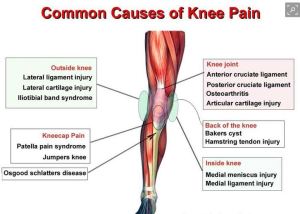If you have ever had knee pain before, you know how difficult it is to perform even the most basic functions in life such as walking or even standing. However, even if an individual is older, knee pain does not automatically mean the only solution available is a total knee replacement. There are many other effective treatments available, including physical therapy treatments, that allow an individual to become pain-free and resume their normal activities. In this post, we will discuss the basic anatomy of the knee, the most common types of injuries, and why this particular joint is different from all other joints in the body.
Knee Joint Anatomy
The knee joint is actually the largest and the most complex joint found in the body. It consists of a tibiofemoral joint that connects the thigh (femur) bone to the shinbone (tibia) in the calf region. There is an additional joint, the patellofemoral joint, which connects the thigh bone to the kneecap. Together these joints allow the knee to not only straighten and bend but rotate slightly from side to side as needed. The knee joints also bear most of the weight in the body, making them particularly vulnerable to wear and tear and injury.

Common Injuries
Since knee joints bear most of the weight in the body, it makes them more susceptible to wear and tear knee injuries such as arthritis, especially in older individuals who are overweight. Bursitis is another common condition in older overweight patients, although it can also occur in younger individuals through a direct blow to the knee or through strenuous activity. There are several bursas, or small fluid-filled sacs surrounding the knee area that provide cushioning to key components of the knee. When one or more of these sacs become inflamed, the individual will experience pain and swelling in the knee area. Excess fluid (edema) around the knee area can also be a symptom of a variety of other issues. Knee trauma, overuse, gout, and tumors are just a few of the causes of fluid build-up around the knee. In some cases, the build-up of fluid behind the knee can develop into something called a Baker’s cyst. Another issue that most commonly occurs from overuse is Plica Syndrome. This syndrome stems from an irritation of the thin tissue (plica) that lines the knee joint. This irritation can cause pain and swelling, as well as a clicking sound, and the patient may have times where their knee either seems to give way or locks altogether.
Other types of conditions are typically due to physical injury or strenuous activities such as basketball, football, tennis, etc. A knee sprain can occur when a person stretches or tears a tendon in the knee area and muscle strains around the knee area can occur from excessive activity. Knee sprains can become chronic and eventually result in knee tendonitis when too much strain is put upon the tendon connecting the kneecap to the shinbone. Knee fractures can occur from a vehicle accident or some type of intense athletic activity where trauma occurs to the knee. Meniscus tears, or tearing of the knee cartilage, is one of the most frequent knee injuries. It often stems from sudden twisting movements found in many athletic activities, but it is also found in older people since meniscus cartilage weakens over time. An ACL (anterior cruciate ligament) injury can be a minor tear in the ligament that joins the thigh bone to the shinbone or it can be more severe, where the ligament tears completely, even separating some of the bone along with the ligament.

Solutions for Knee Pain
For those suffering from knee pain, of course, the first step is to obtain an accurate diagnosis from a qualified physician. A range of treatments including rest, pain medication, synovial fluid injections into the knee, and perhaps surgery in some cases, may all be recommended by a physician. Whether an individual is recovering from knee surgery, or if they have chronic knee pain for which there is no surgery available, physical therapy can often be a big help. Physical therapists can provide a complete program of stretching and strengthening exercises designed to help the muscles surrounding the knee area. Often by strengthening surrounding structures, the irritated areas of the knee receive the necessary support they require, allowing the irritation to gradually clear up. Physical therapists can also recommend proper footwear to wear during recovery, as well as walking, standing, and posture tips to help relieve pressure from the knee area. Pain-relieving treatments such as ultrasound, heat and ice packs, and massage are available as well.

If you would like more information about knee issues and how physical therapy can help you get your life back, please contact us at 570-208-2787 You can send an email to cawleyptfrank@gmail.com.
Bonus: Seven Simple To Do at Home Exercises:

Looking for Relief today?? Click below to sign up for one of our limited Free Discovery Visits!

